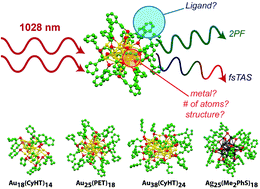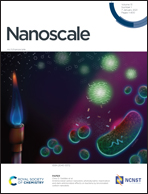Exciting clusters, what does off-resonance actually mean?†
Abstract
Noble metal clusters have unique photophysical properties, especially as a new class of materials for multiphoton biomedical imaging. The previously studied Au25SR18 exhibits “giant” two-photon absorbance cross sections. Herein, we investigate the origins of the large two photon absorption for Au25SR18, as well as 10 other Au and Ag clusters using femtosecond pump/probe transient absorption spectroscopy (fsTAS). Excited state absorbance (ESA) ubiquitous to thiolated Au and Ag clusters is used herein as an optical signature of two-photon absorbances of the 11 different Au and Ag clusters, which does not require high quantum yields of emission. The large selection of clusters, studied with a single laser system, allows us to draw conclusions on the role of the particular metal, cluster size/structure, and the effects of the ligands on the ability to absorb multiple NIR photons. The use of a laser with a 1028 nm excitation also allows us to investigate the dramatic effect of excitation wavelength and explain why laser wavelength has led to large variances in the non-linear responses reported for clusters to date. We discuss the double resonance mechanism, responsible for giant two photon absorbance cross-sections, helping match properties of metal clusters with experimental conditions for maximizing signal/response in multiphoton applications.

- This article is part of the themed collection: Nanoscale 2021 Emerging Investigators


 Please wait while we load your content...
Please wait while we load your content...